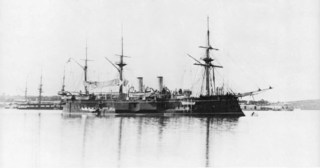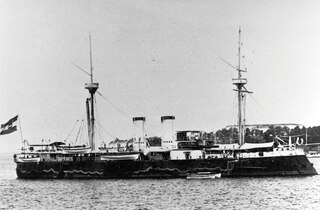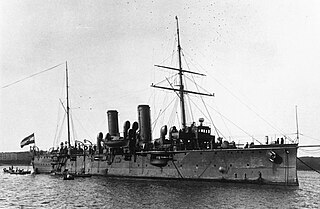
SMS Kaiserin und Königin Maria Theresia was an armored cruiser used by the imperial Austro-Hungarian Navy from 1895 to 1917; she was the first ship of that type built by the Austro-Hungarian Navy. The ship was a unique design, built by the Stabilimento Tecnico Triestino shipyard in Trieste; she was laid down in July 1891, launched in April 1893, and completed in November 1894. Armed with a main battery of two 24-centimeter (9.4 in) guns and eight 15 cm (5.9 in) guns, the ship provided the basis for two subsequent armored cruiser designs for the Austro-Hungarian Navy.

SMS Panther was a torpedo cruiser (Torpedoschiff) of the Austro-Hungarian Navy. She and her sister ship, Leopard were part of a program to build up Austria-Hungary's fleet of torpedo craft in the 1880s. She was the lead ship of her class, and was built in Britain by Armstrong, from her keel laying in October 1884 to her completion in December 1885. She was armed with a battery of two 12 cm (4.7 in) guns and ten 47 mm (1.9 in) guns, along with four 356 mm (14 in) torpedo tubes.

SMS Leopard was a torpedo cruiser (Torpedoschiff) of the Austro-Hungarian Navy. She and her sister ship, SMS Panther, were part of a program to build up Austria-Hungary's fleet of torpedo craft in the 1880s. Both ships, the only members of the Panther class, were built in Britain at the Armstrong shipyard in Elswick. Leopard was laid down in January 1885, launched in September 1885, and completed in March 1886. She was armed with a battery of two 12 cm (4.7 in) guns and ten 47 mm (1.9 in) guns, along with four 356 mm (14 in) torpedo tubes.

SMS Tiger was a torpedo cruiser built for the Austro-Hungarian Navy in the mid-1880s. An enlarged and improved version of the Panther class, she was part of a program to build up Austria-Hungary's fleet of torpedo craft in the 1880s. The Panther class, purchased from a British shipyard, was acquired in part to gain experience building cruisers of the type; this provided the basis for the design of Tiger. She was laid down at the Stabilimento Tecnico Triestino shipyard in October 1886, she was launched in June 1887, and was completed in March 1888. The ship was armed with a battery of four 12 cm (4.7 in) guns and three 35 cm (14 in) torpedo tubes, and was capable of speeds in excess of 19 knots.

SMS Lussin was a torpedo cruiser of the Austro-Hungarian Navy, a modified version of the preceding Zara class. As envisaged by the Marinekommandant, Vice Admiral Friedrich von Pöck, Lussin would be the leader of a flotilla of torpedo boats, with the additional capability of carrying out scouting duties. The ship proved to be too slow and too lightly armed for either of these tasks, so she spent the majority of her career as a training ship for engine and boiler room personnel, along with occasional stints with the main fleet for training exercises. She took part in only one significant operation, an international blockade of Greece in 1886 to prevent the country from declaring war on the Ottoman Empire. In 1910–1913, Lussin was rebuilt as an admiralty yacht, and she spent World War I as a barracks ship for German U-boat crews based in Pola. After the war, she was ceded to Italy as a war prize, renamed Sorrento, and briefly saw service as a mother ship for MAS boats from 1924 to 1928, when she was discarded.

SMS Tegetthoff was an ironclad warship of the Austro-Hungarian Navy. She was built by the Stabilimento Tecnico Triestino shipyard in Trieste, between April 1876 and October 1881. She was armed with a main battery of six 28 cm (11 in) guns mounted in a central-battery. The ship had a limited career, and did not see action. In 1897, she was reduced to a guard ship in Pola, and in 1912 she was renamed Mars. She served as a training ship after 1917, and after the end of World War I, she was surrendered as a war prize to Italy, which sold her for scrapping in 1920.

SMS Kaiser Karl VI was the second of three armored cruisers built by the Austro-Hungarian Navy. She was built by the Stabilimento Tecnico Triestino in Trieste between June 1896 and May 1900, when she was commissioned into the fleet. Kaiser Karl VI represented a significant improvement over the preceding design—Kaiserin und Königin Maria Theresia—being faster and more heavily armed and armored. She provided the basis for the third design, Sankt Georg, which featured further incremental improvements. Having no overseas colonies to patrol, Austria-Hungary built the ship solely to reinforce its battle fleet.

SMS Kronprinz Erzherzog Rudolf was a unique ironclad warship built for the Austro-Hungarian Navy in the 1880s. The last ironclad completed for the Austro-Hungarian Navy, Kronprinz Erzherzog Rudolf was laid down in January 1884, launched in July 1887, and completed in September 1889. She was armed with a main battery of three 30.5-centimeter (12 in) guns and had compound steel plating of the same thickness on her armored belt. The ship had an uneventful career, in large part due to her rapid obsolescence. She made trips to foreign countries to represent Austria-Hungary, but was reduced to a coastal defense ship by 1906. She continued in this role through World War I, based at Cattaro Bay, where her crew took part in the Cattaro Mutiny in early 1918. After the war, Kronprinz Erzherzog Rudolf was transferred to the Navy of the Kingdom of Serbs, Croats and Slovenes, renamed Kumbor and classed as a coastal defence ship, but she remained in their inventory for only a year, being sold for scrap in 1922.

SMS Kronprinzessin Erzherzogin Stephanie was an ironclad warship built for the Austro-Hungarian Navy in the 1880s, the last vessel of that type to be built for Austria-Hungary. The ship, named for Archduchess Stephanie, Crown Princess of Austria, was laid down in November 1884, was launched in April 1887 and completed in July 1889. She was armed with a pair of 30.5-centimeter (12 in) guns in open barbettes and had a top speed of 17 knots. Her service was limited, in large part due to the rapid pace of naval development in the 1890s, which quickly rendered her obsolescent. As a result, her career was generally limited to routine training and the occasional visit to foreign countries. In 1897, she took part in an international naval demonstration to force a compromise over Greek and Ottoman claims to the island of Crete. Kronprinzessin Erzherzogin Stephanie was decommissioned in 1905, hulked in 1910, and converted into a barracks ship in 1914. After Austria-Hungary's defeat in World War I, the ship was transferred to Italy as a war prize and was eventually broken up for scrap in 1926.

SMS Kaiser Max was an ironclad warship built for the Austro-Hungarian Navy in the 1870s, the lead ship of the Kaiser Max class. The ship was purportedly the same vessel that had been laid down in 1861, and had simply been reconstructed. This was a fiction, however; the head of the Austro-Hungarian Navy could not secure funding for new ships, but reconstruction projects were uncontroversial, so he "rebuilt" the three earlier Kaiser Max-class ironclads. Only the engines and parts of the armor plate were reused in the new Kaiser Max, which was laid down in February 1874, launched in December 1875, and commissioned in October 1876. The ship's career was fairly limited, in part due to slender naval budgets that prevented much active use. She made foreign visits and took part in limited training exercises in the 1880s and 1890s. Long since obsolete, Kaiser Max was removed from service in 1904 and converted into a barracks ship. After World War I, the ship was transferred to the Royal Yugoslav Navy as a war prize and renamed Tivat. Her fate thereafter is uncertain, either being sold for scrap in 1924 or retained through 1941.

SMS Prinz Eugen was an ironclad warship built for the Austro-Hungarian Navy in the 1870s, the third and final member of the Kaiser Max class. The ship was supposedly the same vessel that had been laid down in 1861, and had simply been reconstructed. In reality, the head of the Austro-Hungarian Navy could not secure funding for new ships, but reconstruction projects were uncontroversial, so he "rebuilt" the three earlier Kaiser Max-class ironclads. Only the engines and parts of the armor plate were reused in the new Prinz Eugen, which was laid down in October 1874, launched in September 1877, and commissioned in November 1878. The ship spent significant periods out of service, in part due to slender naval budgets that prevented much active use. In 1880, she took part in an international naval demonstration against the Ottoman Empire, and she went to Spain in 1888 for the Barcelona Universal Exposition. Prinz Eugen was stricken in 1904 and converted into a repair ship in 1906–1909. She was renamed Vulkan and served in this capacity through World War I; after the war, she was seized by Italy but was awarded to Yugoslavia in the postwar peace negotiations. Italy refused to hand the ship over, however, and her ultimate fate is unknown.

SMS Don Juan d'Austria was an ironclad warship built for the Austro-Hungarian Navy in the 1870s, the second of the three ships of the Kaiser Max class. The ship was purportedly the same vessel that had been laid down in 1861, and had simply been reconstructed. This was a fiction, however; the head of the Austro-Hungarian Navy could not secure funding for new ships, but reconstruction projects were uncontroversial, so he "rebuilt" the three earlier Kaiser Max-class ironclads. Only the engines and parts of the armor plate were reused in the new Don Juan d'Austria, which was laid down in February 1874, launched in December 1875, and commissioned in October 1876. The ship's career was fairly limited, in part due to slender naval budgets that prevented much active use. She made foreign visits and took part in limited training exercises in the 1880s and 1890s. Long since obsolete, Don Juan d'Austria was removed from service in 1904 and used as a barracks ship through World War I. After the war, she sank under unclear circumstances.

SMS Custoza was an ironclad warship built for the Austro-Hungarian Navy in the 1870s, the only member of her class. She was the first Austro-Hungarian ironclad to be built after the navy studied the results of the Battle of Lissa of 1866; she was also the first iron-hulled capital ship to be built for the Austro-Hungarian Navy. She was laid down in November 1869, launched in August 1872, and completed in February 1875. Her career was fairly limited, in part due to reduced naval budgets in the 1870s that also delayed her completion. Custoza was somewhat more active in the 1880s, taking part in an international naval demonstration against the Ottoman Empire in 1880, being modernized in 1882, and a trip to Spain for the Barcelona Universal Exposition in 1888. The ship became a training ship in 1902, was converted into a barracks ship in 1914, and after World War I, was awarded as a war prize to Italy. Custoza was immediately broken up.

SMS Zara was a torpedo cruiser of the Austro-Hungarian Navy, the lead ship of the Zara class. She was laid down in August 1878, launched in November 1879, and commissioned into the fleet in July 1882. The ship was armed with a battery of light guns and four torpedo tubes. She proved to be poorly designed, being too slow for use as a fleet scout or as a flotilla leader for torpedo boats, so she saw little active service. Throughout the 1880s and 1890s, she was frequently in reserve, being activated infrequently to participate in training exercises. She served as a guard ship in Cattaro Bay for most of World War I, before being withdrawn for use as a cadet training ship in June 1917. She served in this capacity until the end of the war in 1918, and was ceded to Italy as a war prize in 1920. The Italian Navy had no use for the vessel, and sold her to ship breakers in 1921.

SMS Sebenico was a torpedo cruiser of the Austro-Hungarian Navy, the third member of the Zara class, though built to a slightly different design to her two half-sister ships in an unsuccessful attempt to improve her speed. She was laid down in July 1880, launched in February 1882, and commissioned in December that year. Too slow to be used in her intended roles as a fleet scout and a flotilla leader, she saw little active service. She took part in an international naval demonstration off Crete in 1897, where she sank a Greek ship trying to break the blockade. Sebenico served as a training ship for the rest of her career, including with the artillery school from 1903 to 1915, and with the torpedo school until the end of World War I in 1918. Ceded to Italy as a war prize in 1920, she was then broken up for scrap.

The Zara class was a class of three torpedo cruisers built for the Austro-Hungarian Navy in the late 1870s and early 1880s; they were the first large torpedo-armed warships built by Austria-Hungary. The class comprised three ships, Zara, Spalato, and Sebenico; the last vessel was built to a slightly different design, and is sometimes not counted as a member of the class. The design was prepared by Josef von Romako, the Chief Constructor of the Austro-Hungarian Navy, after a lengthy design process throughout the 1870s. The first two ships were armed with deck-mounted torpedo tubes, while Sebenico received an experimental tube in her bow, submerged below the waterline.

The Kaiser Franz Joseph I class was a class of two protected cruisers built for the Austro-Hungarian Navy. Named for Austro-Hungarian Emperor Franz Joseph I, the class comprised SMS Kaiser Franz Joseph I and SMS Kaiserin Elisabeth. Construction took place throughout the late 1880s, with both ships being laid down in 1888. Kaiser Franz Joseph I was built by Stabilimento Tecnico Triestino in Trieste, while Kaiserin Elisabeth was built at the Pola Navy Yard in Pola. The Kaiser Franz Joseph I-class ships were the first protected cruisers constructed by the Austro-Hungarian Navy. Kaiser Franz Joseph I was the first ship of the class to be commissioned into the fleet in July 1890. She was followed by Kaiserin Elisabeth in November 1892.

The Zenta class was a group of three protected cruisers built for the Austro-Hungarian Navy in the 1890s.

SMS Kaiser Franz Joseph I was a protected cruiser built for the Austro-Hungarian Navy. Named for the Austrian emperor and Hungarian king Franz Joseph I, Kaiser Franz Joseph I was the lead ship of her namesake class. Constructed by Stabilimento Tecnico Triestino in Trieste, she was laid down in January 1888 and launched in May 1889. Kaiser Franz Joseph I was commissioned into the Navy in June 1890. As the first protected cruiser constructed by the Austro-Hungarian Navy, she was intended to serve as Austria-Hungary's response to the Italian cruisers Giovanni Bausan and Etna. Her design was heavily influenced by the Jeune École, a naval strategy which had gained prominence in the 1880s as a means to combat a larger and more heavily armored navy of battleships through the use of torpedo flotillas.




















